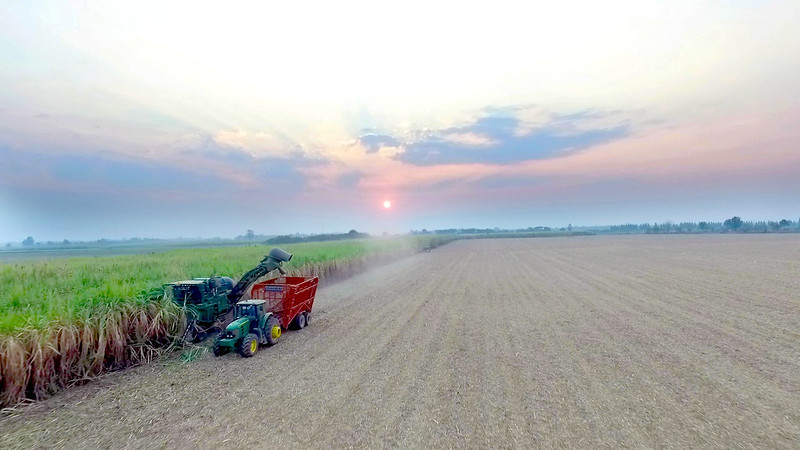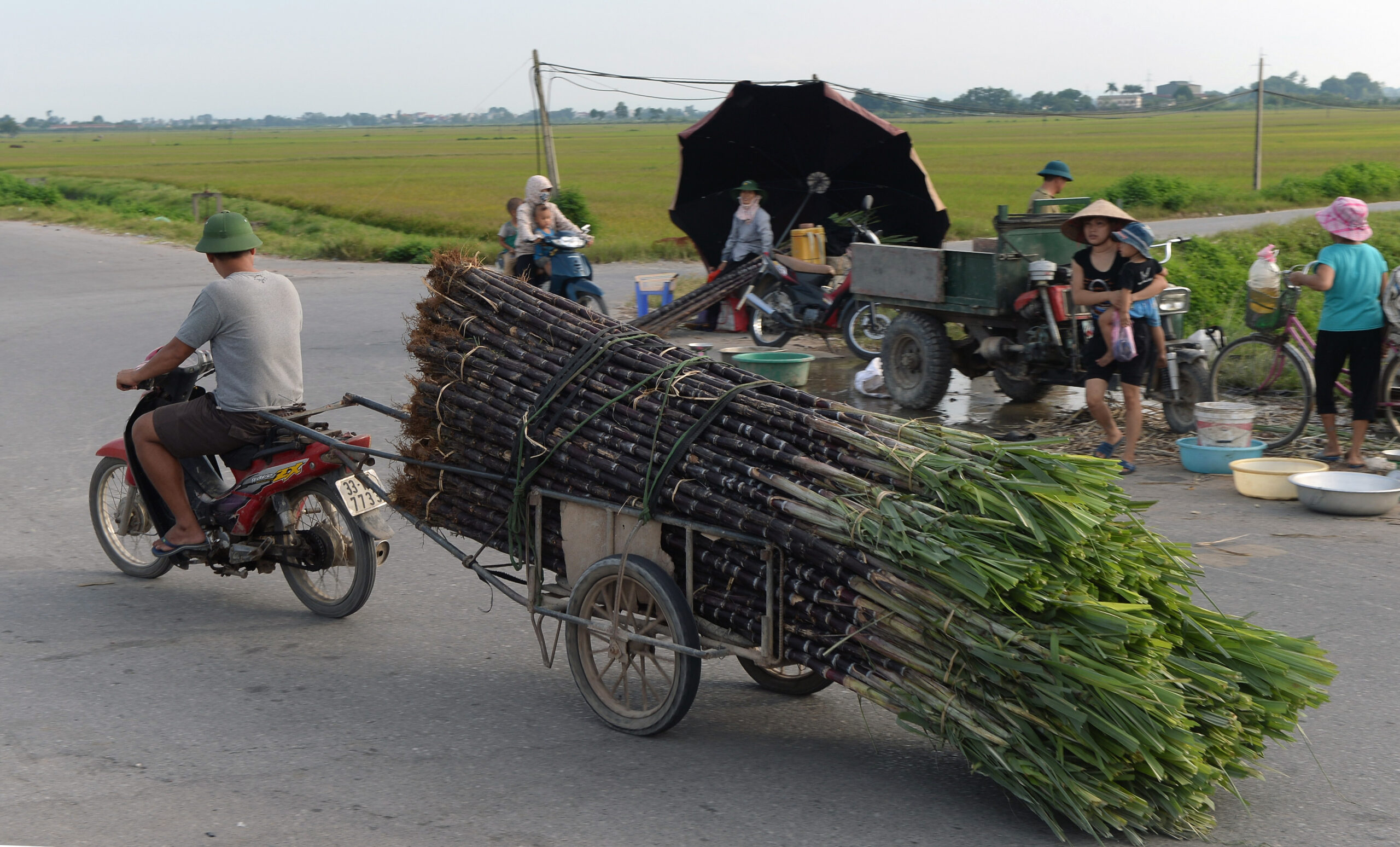On any given day, smugglers pile bags of sugar near the banks of the Mekong River in Cambodia.
After piling it into boats, they then ferry the sweetener into Vietnam’s southwestern provinces, awaited by motorbike drivers who evade custom officials to drop off the commodity at storehouses.
In other cases, smuggling outfits mix the illicit sweetener with sugar produced in Vietnam, or change labels to prevent detection of the bootlegged good. Smugglers have also been known to send Vietnamese packaging to Cambodia to disguise sugar before the contraband is taken across the border.
The sugar is grown, harvested and refined in Thailand where sugarcane fields cover approximately 18,000 square kilometres (6,950 square miles), about the size of four and a half million football fields. While Thailand is one of the biggest exporters of sugar globally, not all of the trade is done legally.
While the smuggling of sugar may not seem as sinister as other goods illegally traded in the region, illicit food goods also pose a threat to Southeast Asia.
“It is important not to underestimate the significance of smuggling legal commodities like sugar,” said Ulrich Meiser, a law enforcement expert covering Southeast Asia for the United Nations Office on Drugs and Crime (UNODC). “It may end up funding other kinds of crime and terrorism.”
Wildlife crime, narcotics production, and the trafficking of persons could be supported by sugar smuggling regionally.
“Criminals are always looking for new opportunities to make profits, in traditional areas like drug smuggling, but also in relation to these kinds of crimes, which can be just as lucrative,” Meiser stated. “There are transnational organised crime groups which may well be involved in such activities.”
It is important not to underestimate the significance of smuggling legal commodities like sugar”
Ulrich Meiser, law enforcement expert, UNODC
Sugar could also generally be used as a “cover load” for concealing drugs and other contraband, Meiser noted. Though far from Asia, UNODC’s container control programme found 960 kilogrammes of cocaine in 2019 concealed in sugar in Colombia.
The amount of sugar illicitly brought into Vietnam from Thailand has been increasing and Laos has been noted as a new entry point for the good. Between 2008 and 2014, 273,571 metric tonnes of sugar were smuggled into Vietnam from Cambodia.
From 2015 to 2019, the amount of sugar has more than doubled with 757,000 metric tonnes of Thai sugar illegally brought into Vietnam. The majority was smuggled through Cambodia but 200,000 tonnes slipped past customs along Vietnam’s shared border with Laos.
The smuggling figures were presented at a seminar on the development of Vietnam’s sugar industry led by the Vietnam Sugar and Sugar Cane Association in February. The president of the association declined requests for comment.
Subsidies, taxes, and Vietnam’s inefficient sugar industry have incentivised smuggling. Thailand puts price subsidies on sugar exports making it cheaper than sugar domestically produced in Vietnam. In addition, production costs for Vietnamese sugar are higher than in Thailand and protective taxes on imported sugar have exacerbated smuggling due to the difficulty of monitoring Vietnam’s long and porous border region.
According to Vo-Tong Xuan, former chairman of Vietnam’s market-leading TTC Sugar and professor at Nam Can Tho University, sugar smuggling techniques have become more advanced and pose a threat to Vietnamese sugarcane farms, sugar mills, and businesses.
“Fraudulent acts of sugar trade are still a risk with more and more sophisticated and complex forms,” he wrote, in a review on the country’s sugar industry between 2020 and 2022.
“Authorities need to continue to improve measures to prevent fraudulent acts of sugar trade.”

Timber, tobacco, methamphetamine and other synthetic drugs are part of the network of illicit goods smuggled across the Mekong region. While many commodities have end-destinations in and out of Vietnam, sugar takes a one way route to be sold in the Southeast Asian nation.
Smugglers often take advantage of ever-increasing trade flows in the region, putting authorities in a tough spot where it is near-impossible to check everything crossing the border, Meiser stated. Although UNODC’s work in Vietnam has focused primarily on the drug trade, he suspects a varied group of smugglers could be involved in the illegal sugar trade.
“As with most cases of smuggled legal goods, there are a range of actors involved, from individual traders and small-time criminals to larger businesses and criminal syndicates,” he said.
The incentives for smuggling the sweetener and the country’s sugar woes go back further than recent upticks in the amounts of illegal sweetener entering Vietnam through Cambodia and Laos.
Tom Arnold, professor of finance at the University of Richmond, said government programmes to court foreign direct investment into Vietnam’s sugarcane industry in the 1990s backfired, creating inefficiencies that opened space in the market for smuggling.
In 1986, Vietnam began liberalising its markets to boost the economy after decades of conflict left the country one of the poorest in the world. By the mid-1990s, the Vietnamese government looked to develop a sugar industry, creating incentives for investors.
You stop it in one spot, it just moves to another.”
Tom Arnold, professor of finance, University of Richmond
As part of the “One Million Tonne Sugar Programme,” investors in Vietnam’s sugar industry would have a contracted supply of sugarcane, improved transportation infrastructure from field to mill, restrictive taxes inflating domestic sugar prices and quotas restricting imported sugar.
But promises on transportation routes from sugarcane farms to mills never materialised. And the longer the period sugarcane sits from the time it is cut to when it is crushed, the less sugar can be produced from each cane.
“You have to be able to get [sugarcane] from the field to the mill as fast as possible if you want to get the most production out of that sugarcane,” Arnold said. “The infrastructure just never appeared when all was said and done.”
This inefficiency in sugar production was worsened by investment in small sugar mills rather than larger structures. Although large mills could increase savings with high levels of production, mills valued above approximately $4,316 (100 million Vietnamese dong)) needed approval from three ministries and Vietnam’s prime minister causing smaller mills to pop up faster.
With small mills, poor infrastructure, difficulties monitoring contracts, and not-ideal topography for sugarcane plantations, the price of sugar manufacturing in Vietnam is high.
“The fact of the matter is it’s cheaper to produce outside the country, so now you have an incentive to try to smuggle it into the country and all you really have to do is charge a price that’s lower than the domestic producer,” Arnold said. “You can sell it at a lower price and still make a tremendous amount of profit.”
Protective tariffs placed on local sugar also had downsides. To boost the industry’s growth, protective import tariffs were imposed that were at times more than 70% higher than the world price of sugar during the outset of the country’s sugar industry push.
The difficulty of protecting borders from smuggling and the low-efficiency in Vietnam’s sugar industry have made smuggling a lucrative endeavour. While protective taxes on the domestic product could benefit Vietnam if it were possible to secure borders, Vietnam shares a 1,158 kilometre (720 miles) border with Cambodia and a 2,161 kilometre border (1,343 miles) with Laos.
“When you have to rely on tariffs to protect the local industry and you have a big porous border, It’s a recipe for smuggling,” Arnold said. “[Sugar] is relatively easy to hide… usually you’re going to have some complicity inside and outside of the border.”
“It’s just so hard to combat. You stop it in one spot, it just moves to another.”

Xuan noted smuggling, low sugar prices, “fierce competition” from imported sugar, and climate change as the leading hardships facing Vietnam’s sugar producers. Although he sees some positive signals for the industry, many sugarcane enterprises are in decline.
There were 41 sugar mills in operation in 2016 but nearly half have gone bankrupt and are no longer operating, according to research published in the trade journal Sugar Tech. There are currently 24 mills open, as stated in Xuan’s review of the industry.
Farmers are also leaving sugarcane behind to seek more profitable and stable ventures. Some sugarcane fields were abandoned and without being fertilised or irrigated, the crops had reduced yields, Xuan noted.
Despite the issues, Xuan sees a “rosy picture” for production of the sweetener in Vietnam as prices of the refined sugar have been inching upwards.
Although Vietnam signed the ASEAN Trade in Goods Agreement in 2019 which prohibits the taxation of goods between ASEAN member countries, there is wriggle room to protect local industries. In 2020, after the trade deal went into effect, six enterprises in the sugar industry wrote to the Ministry of Industry and Trade (MOIT) explaining how Thai sugar imports were hurting business.
According to the complaint, 1.3 million tonnes of subsidised Thai sugar was imported into Vietnam, a 330.4% increase from the year prior. MOIT began an investigation into the issue finding 90,000 farmers have been impacted by the flood of Thai sugar coming into the country and 3,000 workers lost jobs.
Last summer, MOIT imposed a “drastic anti-dumping tax and anti-subsidy tax” on some Thai sugar products, Xuan noted, a move he believes should benefit Vietnamese sugarcane enterprises.
Still, the taxes only inhibit legal flows of the sweetener and adversely the “almost 50% anti-dumping levy” incentivises smuggling, Meiser noted. “Whenever goods are taxed, there is an incentive to illegally smuggle those products into the country to avoid the tax,” he said.
Xuan argued more needs to be done to track and control illicit trade. Along with the government amping up control of the border, domestic sugar players need to step up to monitor illegal goods.
“Enterprises need to set up a tracking system to collect information on market movements and fraudulent trade activities to promptly provide them to state agencies,” Xuan wrote. “[They need to] deploy a traceability system to help prevent commercial fraud to assist authorities in distinguishing fake, counterfeit, smuggled, and commercial frauds.”
For Meiser, while Vietnamese authorities generally do a “great job” monitoring borders, they face huge challenges due to the scope of land and sea borders and increasing trade.
While awareness raising, training, cooperation between the private sector and customs operators and the advancement of technology could improve border security, “there is no substitute for trust, timely information sharing, and law enforcement cooperation; between countries, between agencies, and with the private sector,” he said.
“Each year trade flows increase, and criminals adopt more sophisticated techniques to evade authorities,” he added.
In the meantime, many sugarcane farmers are struggling to make the most of their investments in the crop.
Tho Truong, who runs an online group for sugarcane farmers to share tips on productivity and quality of crops, was raised on a farm in Tay Ninh Province along the border with Cambodia. His relatives grow between 400 and 700 hectares (988 and 1730 acres) of sugarcane and sell their yields to sugar mills after harvest. Tho said there are “high investment costs [and] low sugarcane prices” and smuggling is another hindrance for farmers.
“Thai sugar is smuggled a lot,” Truong said. “Most farmers abandon Vietnamese sugarcane.”
Although he is passionate about growing sugarcane, the cost associated with farming is too high. Despite wanting to farm sugarcane when he was young, Truong didn’t find it a viable career. He is currently working in the solar industry.
“I’m sad because I can’t make sugarcane anymore, so I consider it a good memory,” he said.


